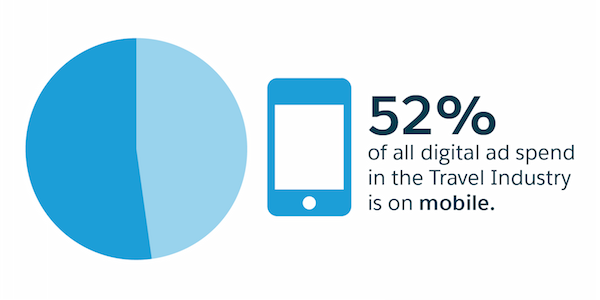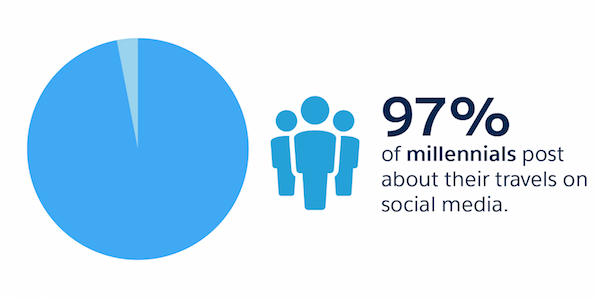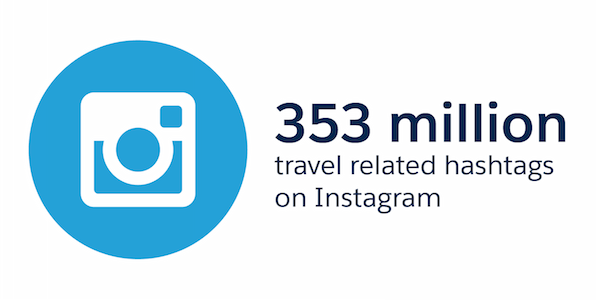
Get your FREE 30-day trial.
Please complete all fields.
The travel industry has increased spend significantly, especially on mobile, in the digital advertising industry since 2014. Travel advertisers have discovered the value in using platforms like Instagram and Facebook to reach today’s hyper-connected travelers. Millennials are the most valuable audience for advertisers as the leading travel generation. This mobile-first group is making travel possible when and where ever, and advertisers would do best to consider this group heavily in building their next campaign. In addition, Instagram offers advertisers a highly-active and travel-savvy user base that today finds more and more travel related hashtags everyday.
This year, the travel industry ranks within the middle of the pack in terms of share of total U.S. digital ad spending. This year, the travel industry reaches $4.6 billion in digital ad spend, increasing to $7.3 billion by 2019. Of the $4.6 billion in ad spend, 74% ($3.1 billion) is used for direct-response objectives, while the other 26% ($1.1 billion) is designated as branding. Mobile share of digital ad spend in the travel industry is growing and in the future will own the majority of total digital ad spend, this year making up 52% of all digital at $2.4 billion on mobile alone.

If there is one group advertisers should keep in mind when planning their next ad campaign, it is millennials. Today, millennials are 23% more likely to travel abroad than any other generation. In addition, 97% of millennials post about their travels on social media, and 42% of all posts on the average user’s timeline are travel related.

Millennials are also the leaders in the mobile movement especially when it comes to travel planning and purchasing. This generation has the highest mobile penetration of any age group and are using their devices more and more; 75% use a mobile device to access the internet (as opposed to desktop) and 18% of which is mobile-only. For this reason, travel advertisers should create mobile-friendly campaigns to appeal to these mobile users. Millennials also tend to book more spontaneous trips than any other generation, particularly last minute accommodations and transportation. Given the mobile-first nature of this generation who are always connected, smart travel brands will use mobile apps to secure the last minute bookings. In addition, Expedia reports that 32% of Millennial business travel is booked via mobile devices.
Today, travelers all over the world are sharing their trips not only with those accompanying them on their journey, but with everyone on their networks. Approximately 72% of all travelers on social media post about their travels while still on vacation. For this reason it’s no surprise why 84% of tourism brands use Facebook to promote their business and over 45% of brands use Twitter Lead Generation Cards. Those are just two of the many platforms attracting travel advertisers today.
Instagram, the most recent network to offer advertising, has reached over 400 million users today, with 59% of users visiting the platform everyday and used by 55% of all millennials. In addition to its growing, loyal userbase, Instagram is an especially travel-friendly advertising platform given its visual nature. Travel related content owns a vast share of the platform’s shared content. Today, there are over 353 million travel related hashtags on Instagram, and that number is growing. This year, #europe and #italy were the top 2 most popular travel hashtags. Not only are users sharing their journeys but also searching for inspiration for their next destination. By paying attention to the most popular hashtags, you can engage in trending conversations and incorporate what you see and hear to target the right travelers in your next ad campaign.

Take advantage of trending topics and audience posts before you plan your next campaign. Let your audience be your inspiration and hope to inspire others in return. Here are some tips every advertiser on Instagram, Twitter and other platforms, can use to find success:
Take advantage of trending topics or hashtags to create posts that will appeal to a broader audience.
Pay attention to the images your audience is posting. By knowing what destinations or types of travel interest them, you can better appeal to various audiences in your next campaign.
Use what you already know about your customers to make their trip the best one yet. For example, if a customer books a flight with your airline, use that data to personalize your communications leading up to their departure.
Many users visit Twitter to get the buzz on what’s going on in the world. Next time a major event is taking place that relates to your brand, take the opportunity to advertise to your Twitter followers. For example, before Sundance Film Festival this upcoming January, hotel brands in Park City, Utah should add their proximity to the festival or a particular promotion offered that week to attract film festival attendees.
Listen to what's happening on mobile. Given the prevalence of mobile in the travel industry, use data about your mobile app installs and in-app activity to optimize your advertising to various audience segments.
Add hashtags to your Instagram posts related to emotions, tastes, or community to inform your audience of all the additional opportunities and benefits that travel offers. For example, adding #winetasting and #girlsweekend would appeal to females interested in a potential girls trip.
Sell an experience, not a travel package. Users will respond better to beautifully-crafted, inspiring posts that give them a glimpse of how their future vacation could look.
However, everyone, especially millennials, love a good deal. So find a way to notify your audience of any promotions.
To get more tips for success with advertising in the travel industry, check out our case study with TripIt, the world’s highest-rated travel-organizing app.